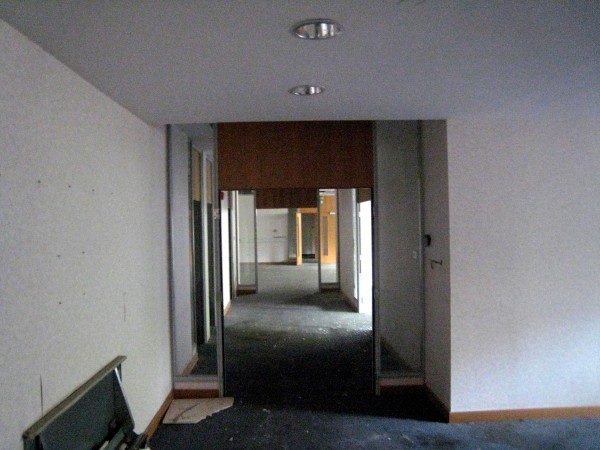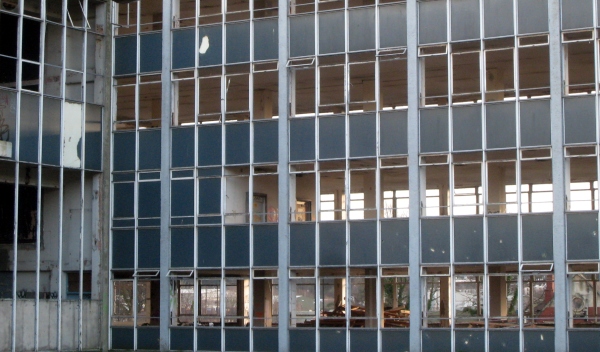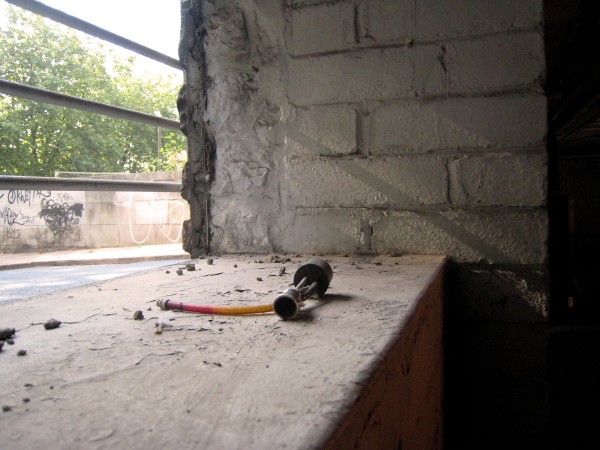In empty buildings
Guns were trained on me: I gasped as I quickly surveyed the seemingly innumerable brace of barrels. Instinctively, instantly, I turned and fled, head down, sprinting with all of my (limited) strength. Shouts, not shots, rang out as I barged through the double doors ahead of me, they were following, not firing. I looked up. A corridor stretched out ahead of me, light cast down from a broken skylight. I ran ahead, flying through fire doors, almost slipping on the dark pool of blood spread out from a lifeless body half-in, half-out, a small room on the left hand side. There was a telephone cast on the ground beside her. I didn’t know where I was, but it felt familiar, the house of an anonymous institution, now abandoned, predictable in its layout. I could hide here.
 Where the eye leads, the body follows…
Where the eye leads, the body follows…
I seem to be haunted by nightmares at the moment, all of them disappointingly simplistic in plot and detail when I recall them, but truly terrifying in my sleep. This morning I woke from another, confused as to why I was being hunted, but filled with a different kind of uneasiness, one which has confronted me many times in my waking life as an archaeologist. There is an unnerving uncanniness to walking into a recently abandoned building. Over the years I have put trenches through the basements and car parks of all kinds of office blocks, homes and institutions, and I always find it slightly unsettling. Everything in them accords with my lived experience, and I picture the building brightly lit, populated with people typing, chattering and making coffee. Reality doesn’t cater to my imaginings, however, and some part of my denied mind senses that something must be wrong.
 Alluringly unnerving.
Alluringly unnerving.
Despite my uneasiness, I enjoy exploring these buildings. There was an old children’s hospital (it had a padded cell! I didn’t know they were still used!) and any number of vast multi-storey office blocks with basement tunnels stretching beneath them, where silver pipes lead to dark and complex plant rooms. Sometimes the offices are freshly empty, the windows boarded up, upturned mugs still sitting hopefully in dishwasher racks. More often, the building has been bereft of its corporate occupants for some time. Windows are broken and wiring has been ripped out. The artefacts of a more ephemeral human use are visible: needles and spoons, polystyrene food boxes and underwear. Their moment is fleeting – no trace that these buildings were ever anybody’s home will survive for future archaeologists, but human lives have been lived there – a shadow story to the recognisable building history.
 I think Schiffer calls this ‘primary deposition’
I think Schiffer calls this ‘primary deposition’
The least comfortable I felt was on a site in rural Somerset. We had been given use of an empty bungalow for indoor space to take lunch and complete paperwork while we excavated in the garden. The last occupant had passed away but little had been done to draw a close to the material aspects of his life. The house was almost intact, save that the heating, electricity and water were off, save that a window was broken and a sparrow flitted noisily between the rooms. There was an object that looked like it might be a beer can wrapped as a Christmas gift on the kitchen counter. It was hard not to be touched by sadness.
As archaeologists, we find ourselves in places that have been abandoned by their people everywhere we work. Occasionally we find glimpses of individuals – unknowable to us but recognisable in their intentions – a potter’s thumb mark, the debitage of skillfully crafted arrowhead, a seemingly makeshift repair in a waterlogged wooden structure – which resonate with our experiences and connect us despite the centuries. Rarely, however, do we have either as well-preserved a record, or as familiar a built environment, as in these unintended archaeological site explorations. But perhaps one day I’ll develop the imagination to dream of being chased into a roundhouse and feel that it is familiar.